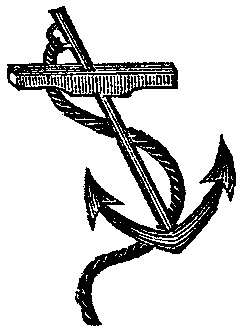Get Today in Masonic History into your Inbox. Sign up today for one of our email lists!
Need an article for your Trestleboard/Newsletter see our Use Policy
The Anchor

Today in Masonic History we discuss the Anchor.
The Anchor is a symbol of well-grounded hope and a life well spent.
The Anchor has long been a symbol of stability. It is believed it became a symbol of hope with early Christians. Drawings and carvings in the catacombs of Rome depict the early usage of this symbol in the Christian faith.
It is not surprising the symbol of the anchor was adopted by early Christians. They saw life as a "stormy voyage." Seafarers, probably from the beginning of travels by sea, saw the anchor as the only way to survive a rough sea. The Anchor gave the early seafarers a sense of Hope to survive an angry sea or massive storm.
The depiction of a boat and an anchor were often linked. It was not until early Freemasons when the Anchor became connected with the images of Noah's Ark. In fact in early Masonic writings the Anchor is not even seen as a symbol associated with the fraternity.
Around the time of the founding of the Grand Lodge of England, there was a lot of interest in the "postdiluvian world." Postdiluvian of course referring to what came after the biblical flood of Noah. It makes sense Masons from around the time sought out symbols associating the Masonic fraternity with the period. This tied Freemasonry with the biblical flood, cementing it in the early days of speculative Masonry.
For Freemasons, the images of the Ark and the Anchor are meant to remind us, of the rough travels in our lives. By Anchoring ourselves with well founded Hope we can weather the storms of life.
This article provided by Brother Eric C. Steele.

